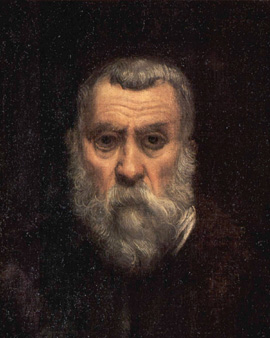The Venetian painter was born as Jacopo Robusti. As the son of a dyer, he was traditionally given the nickname "Tintoretto" - the little dyer - which Jacopo later used as his stage name. There are only vague records of the artist's career. Jacopo seems to have maintained a close relationship with Titian, which was not exclusively friendly. It is certain that Tintoretto worked in the Venice area, opened a workshop here and left the footprints of his great work.
Jacopo Tintoretto's paintings were often denominational. His works are compositions of multifaceted situations. The artist achieves pictures full of movement and with perspectives that are aligned in depth, which speak for Tintoretto's great artistic talent. In the paintings "The Last Supper" and "The Adoration of the Golden Calf" there are soft areas of colour and, on closer inspection, identical figures from different perspectives. Before the beginning of a painting, the artist created small wax figures, which he depicted from different angles in his works.
Tintoretto's work was criticised during the period of his creation. He would work too fast, his brushstrokes are set too hectically and too restless. His works were controversial, yet Jacopo received commissions to paint altarpieces. Jacopo's motto was to combine Michelangelo's drawings and the colourfulness of a Titian in his paintings. Besides the criticism, Tintoretto was one of the most respected painters of his time, far beyond Venice.
×





.jpg)
.jpg)
.jpg)
.jpg)
_-_(MeisterDrucke-1426256).jpg)
_-_(MeisterDrucke-1426256).jpg)
.jpg)
.jpg)
.jpg)
.jpg)
.jpg)
.jpg)
.jpg)
.jpg)
.jpg)
.jpg)
.jpg)
.jpg)
_(1518-_-_(MeisterDrucke-973884).jpg)
_(1518-_-_(MeisterDrucke-973884).jpg)
.jpg)
.jpg)
.jpg)
.jpg)
.jpg)
.jpg)
.jpg)
.jpg)
.jpg)
.jpg)
.jpg)
.jpg)
.jpg)
.jpg)
_-_(MeisterDrucke-1585054).jpg)
_-_(MeisterDrucke-1585054).jpg)
.jpg)
.jpg)
_(1518-159_-_(MeisterDrucke-1001543).jpg)
_(1518-159_-_(MeisterDrucke-1001543).jpg)
.jpg)
.jpg)
.jpg)
.jpg)
.jpg)
.jpg)
.jpg)
.jpg)
.jpg)
.jpg)
.jpg)
.jpg)
.jpg)
.jpg)
.jpg)
.jpg)
.jpg)
.jpg)
_-_(MeisterDrucke-1642283).jpg)
_-_(MeisterDrucke-1642283).jpg)
.jpg)
.jpg)
.jpg)
.jpg)
_(1518-1594)_1565_Dim_536x12_-_(MeisterDrucke-984135).jpg)
_(1518-1594)_1565_Dim_536x12_-_(MeisterDrucke-984135).jpg)
.jpg)
.jpg)
.jpg)
.jpg)
.jpg)
.jpg)
 - (MeisterDrucke-255482).jpg)
 - (MeisterDrucke-255482).jpg)
.jpg)
.jpg)
 - (MeisterDrucke-195554).jpg)
 - (MeisterDrucke-195554).jpg)
.jpg)
.jpg)
.jpg)
.jpg)
.jpg)
.jpg)
.jpg)
.jpg)
_-_(MeisterDrucke-1582501).jpg)
_-_(MeisterDrucke-1582501).jpg)
.jpg)
.jpg)
.jpg)
.jpg)
.jpg)
.jpg)
.jpg)
.jpg)
.jpg)
.jpg)
.jpg)
.jpg)
.jpg)
.jpg)
.jpg)
.jpg)
.jpg)
.jpg)
.jpg)
.jpg)
.jpg)
.jpg)
.jpg)
.jpg)
.jpg)
.jpg)
.jpg)
.jpg)
.jpg)
.jpg)
.jpg)
.jpg)
_-_(MeisterDrucke-1583853).jpg)
_-_(MeisterDrucke-1583853).jpg)
.jpg)
.jpg)
_-_(MeisterDrucke-1460611).jpg)
_-_(MeisterDrucke-1460611).jpg)
.jpg)
.jpg)
.jpg)
.jpg)
.jpg)
.jpg)
_Paint_-_(MeisterDrucke-1036164).jpg)
_Paint_-_(MeisterDrucke-1036164).jpg)
.jpg)
.jpg)
.jpg)
.jpg)
.jpg)
.jpg)
.jpg)
.jpg)
.jpg)
.jpg)
.jpg)
.jpg)
_-_(MeisterDrucke-901804).jpg)
_-_(MeisterDrucke-901804).jpg)
.jpg)
.jpg)
.jpg)
.jpg)
 Commander-in-Chief of the Venetian forces in the war against the Ottoman Empire with the battle of Lepanto in the background c1571 - (MeisterDrucke-53210).jpg)
 Commander-in-Chief of the Venetian forces in the war against the Ottoman Empire with the battle of Lepanto in the background c1571 - (MeisterDrucke-53210).jpg)
.jpg)
.jpg)
.jpg)
.jpg)
_drawing_in_bl_-_(MeisterDrucke-1103850).jpg)
_drawing_in_bl_-_(MeisterDrucke-1103850).jpg)
.jpg)
.jpg)
_(The_Carriage_of_the_Cross)_Painting_-_(MeisterDrucke-1022551).jpg)
_(The_Carriage_of_the_Cross)_Painting_-_(MeisterDrucke-1022551).jpg)
.jpg)
.jpg)
.jpg)
.jpg)
.jpg)
.jpg)
.jpg)
.jpg)
 - (MeisterDrucke-268929).jpg)
 - (MeisterDrucke-268929).jpg)
 originally Tatti sculptor and State architect in Venice - (MeisterDrucke-67120).jpg)
 originally Tatti sculptor and State architect in Venice - (MeisterDrucke-67120).jpg)
.jpg)
.jpg)
.jpg)
.jpg)
.jpg)
.jpg)
.jpg)
.jpg)
.jpg)
.jpg)
_-_(MeisterDrucke-1634112).jpg)
_-_(MeisterDrucke-1634112).jpg)
.jpg)
.jpg)
.jpg)
.jpg)
.jpg)
.jpg)
_-_(MeisterDrucke-310387).jpg)
_-_(MeisterDrucke-310387).jpg)
.jpg)
.jpg)
.jpg)
.jpg)






